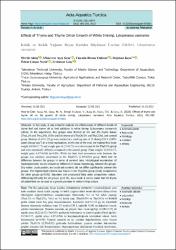Effects of Thyme and Thyme Oil on Growth of White Shrimp, Litopenaeus vannamei

Göster/
Tarih
2022Yazar
Aktaş, MevlütGenç, Münevver Ayçe
Bircan Yıldırım, Yasemin
Kaya, Doğukan
Çalışıcı Narin, Özlem
Genç, Ercüment
Üst veri
Tüm öğe kaydını gösterKünye
Aktaş, M., Genç, M. A., Bircan Yıldırım, Y., Kaya, D., Çalışıcı, Ö. & Genç, E. (2022). Effects of Thyme and Thyme Oil on Growth of White Shrimp, Litopenaeus vannamei . Acta Aquatica Turcica, 18 (1) , 81-92. https://doi.org/10.22392/actaquatr.976901Özet
In this study, it was aimed to evaluate the effectiveness of different levels of thyme leaf and thyme oil as feed additives in white shrimp (Litopenaeus vannamei) culture. In the experiment, five groups were formed as 1% and 2% thyme leaves (ThyL1% and ThyL2%), 0.5% and 1% thyme oil (ThyO0.5% and ThyO1%), and control group. Shrimps (6.67±1.52 g) were stocked at a stocking rate of 15 shrimp/250 L (100% water change day-1) in a three-replications. At the end of the trial, the highest final body weight (14.90±2.77) and weight gain (8.22±0.72) were determined in the ThyO1% group and were statistically different compared to the control group (Final weight: 13.54±3.37, weight gain: 6.87±0.54) (p<0.05). While the best feed conversion ratio between the groups was similarly determined in the ThyO1% (2.59±0.92) group, there was no difference between the groups in terms of survival rates. Histological examination of hepatopancreatic tissues showed no difference in tissue morphology between the groups. Dry matter, crude protein, and crude ash contents did not differ significantly between the groups. The highest lipid content was found in the ThyO1% group (1.64) compared to the other groups (p<0.05). Saturated and unsaturated fatty acids composition values differed significantly for all groups. (p<0.05). As a result, it can be stated that 1% thyme oil added feed can be used as a growth promoter in white shrimp culture. The Bu çalışmada, beyaz karides (Litopenaeus vannamei) yetiştiriciliğinde yem katkı maddesi olarak kekik yaprağı ve kekik yağının farklı besin takviyesi düzeylerinin etkinliğinin değerlendirilmesi amaçlanmıştır. Denemede, %1 ve %2 kekik yaprağı (ThyL1% ve ThyL2%), %0,5 ve %1 kekik yağı (ThyO0.5% ve ThyO1%) ve kontrol grubu olmak üzere beş grup oluşturulmuştur. Karidesler (6,67±1,52 g), üç tekerrürlü deneme düzeninde stoklama oranı 15 karides/250 L (günlük %100 su değişimi) olacak şekilde stoklanmıştır. Deneme sonunda, en yüksek final vücut ağırlığı (14,90±2,77) ve ağırlık artışı (8,22±0,72) ThyO1% grubunda belirlenmiş ve kontrol grubu (Final ağırlık: 13,54±3.37, ağırlık artışı: 6.87±0.54) ile karşılaştırıldığında istatistiksel olarak farklı bulunmuştur (p<0.05). Gruplar arasında en iyi yemden değerlendirme oranı benzer şekilde ThyO1% (2,59±0,92) grubunda belirlenirken, yaşama oranları bakımından gruplar arasında fark bulunmamıştır. Hepatopankreas dokularının histolojik incelemesi, gruplar arasında doku morfolojisi açısından fark olmadığını göstermiştir. Kuru madde, ham protein ve ham kül içerikleri gruplar arasında önemli ölçüde farklılık göstermemiştir. En yüksek lipid içeriği ThyO1% grubunda (1,64) saptanmış ve diğer gruplarla karşılaştırıldığında istatistiki fark oluşturmuştur (p<0.05). Doymuş ve doymamış yağ asitleri kompozisyon değerleri tüm gruplar için anlamlı farklılık göstermiştir. (p<0.05). Sonuç olarak, %1 kekik yağı katkılı yemin beyaz karideslerde büyüme destekleyicisi olarak kullanılabileceği ifade edilebilir.
Kaynak
Acta Aquatica TurcicaCilt
18Sayı
1Bağlantı
https://doi.org/10.22392/actaquatr.976901https://hdl.handle.net/20.500.12508/2459
https://dergipark.org.tr/tr/pub/actaquatr/issue/68388/976901















